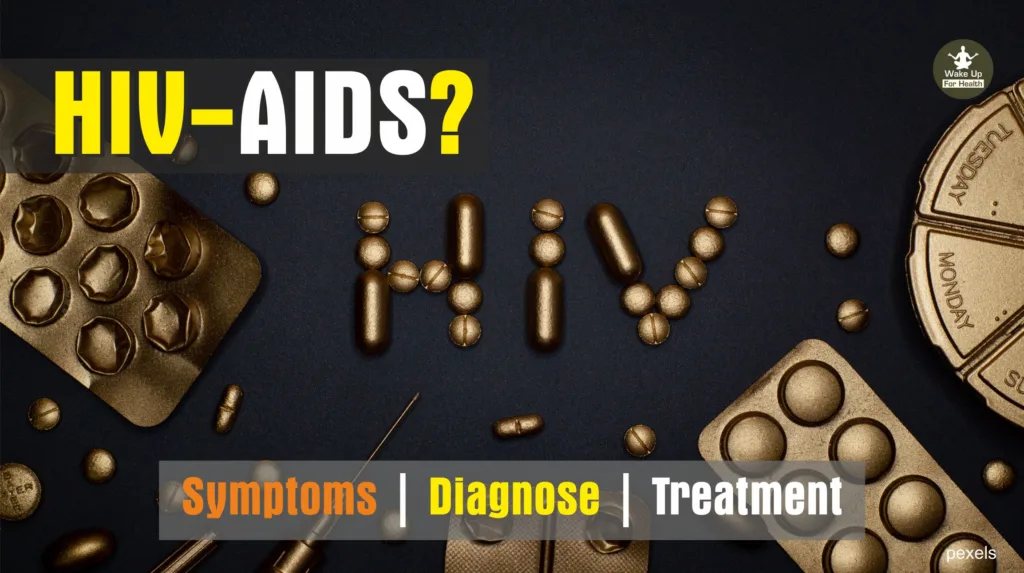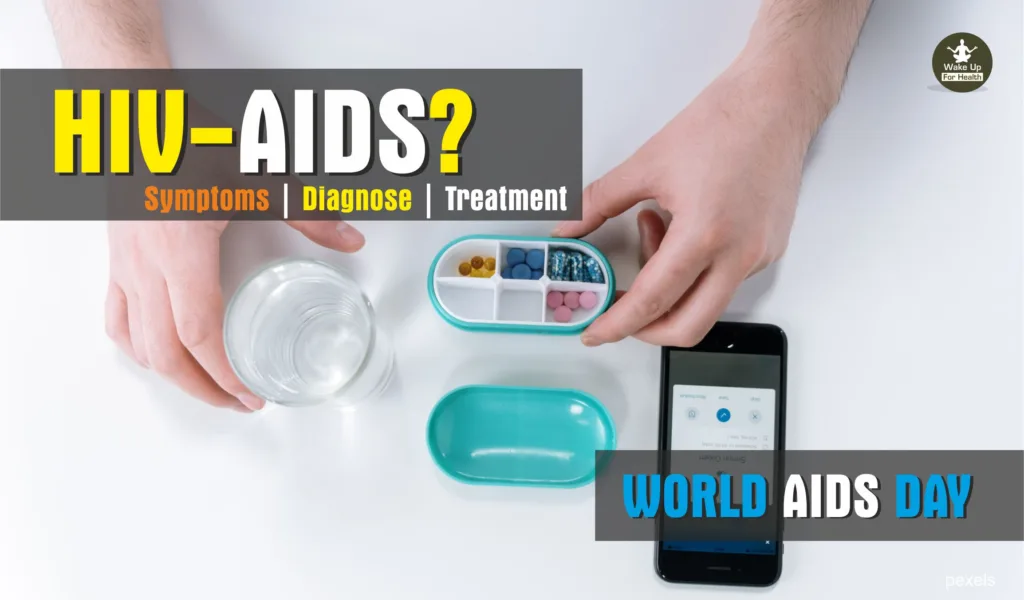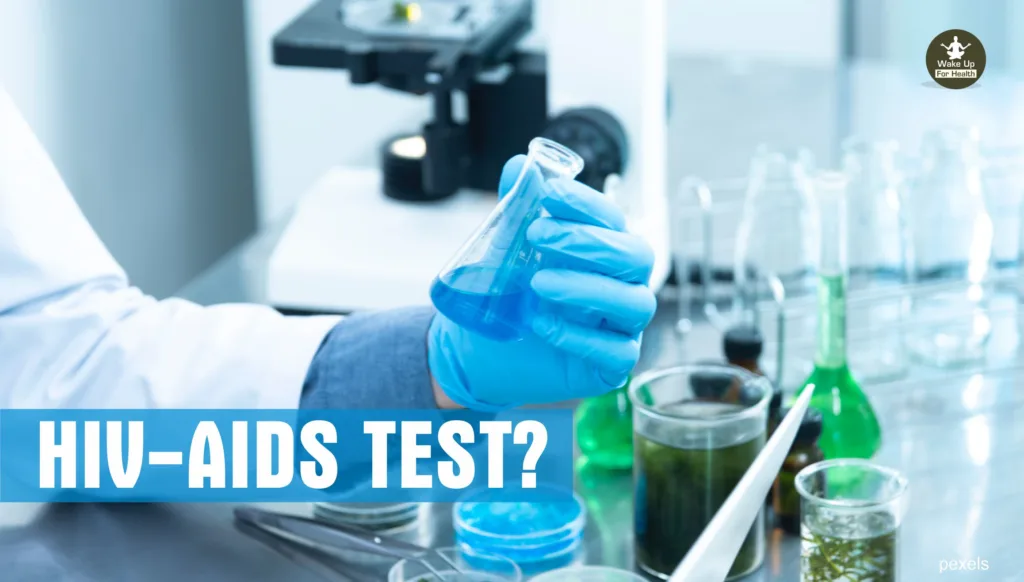On hearing the name of HIV AIDS, a picture of a terrible and serious disease comes to the fore. By the way, most of the diseases are serious and bad, but on hearing the name of HIV AIDS, everyone gets goosebumps because everyone knows that AIDS is such a serious disease in which the person gives up the will to live and gets depressed badly. Here we are sharing HIV and AIDS treatment, HIV Symptoms, AIDS Causes, AIDS diagnosis and AIDS Prevention and use of Antiretroviral Drugs.

That’s why it is very important to know what is HIV AIDS and how it happens, what are its symptoms, how can it be prevented. So that we can get treatment for this disease in time and live a healthy life.
What is HIV AIDS?, Symptoms, Causes, Antiretroviral Treatment, Prevention Strategies
HIV is called human immunodeficiency virus (HIV), it is a type of virus that goes into our body and damages the cells (CD4 cells or T cells) that fight diseases in our body and keep us healthy. This virus weakens our immune system and makes us ill, which makes it easier for this virus to infect our body. And its infection not only makes a person sick but can also kill him.
Difference Between HIV and AIDS
HIV is a type of virus that causes AIDS. AIDS is also known as acquired immune deficiency syndrome. It would be absolutely wrong to call HIV and AIDS the same thing, because it is not necessary that people suffering from HIV always have AIDS.
The possibility of AIDS in a person increases when CD4 or T cells have been heavily infected with HIV and have become very weak because then our body’s ability to fight against diseases is over and our body is very weak. it happens. AIDS is considered to be the most dangerous level of HIV because a person can die after having AIDS.
HIV Causes AIDS
There are many reasons for having HIV AIDS, whose list is given below-
Establishing Unprotected Sex
If you establish unprotected sex with any HIV affected person, then you may also have the possibility of getting AIDS, this can also be the main reason for getting AIDS.

Transfusion of Contaminated Blood to Someone
If the blood of an HIV positive person is transfused to a healthy person, then even in this situation the chances of that healthy person getting AIDS increases.
Do You Know : Teenage Stress | Causes of Teenage Stress | How Parenting of Parents Reduce Teenage Pressure
Using an Infected Needle
There is always a risk of getting infected with HIV even by using a needle used by someone else. Most people also use each other’s used needles to take drugs, but that person may be HIV infected, which can also put your life at risk and also use another person’s syringes for tattooing or piercing. syringes) or needles can be dangerous to use.
HIV-infected mother breastfeeding her child- If a woman who is already HIV-infected gives birth to a child and breastfeeds it, there is a possibility that the mother may transmit AIDS to that child by breastfeeding. Therefore, before the birth of the child, the woman should get herself examined and treated.
Giving birth to a child by an infected pregnant woman- If a woman is pregnant then she should get her HIV test done in the initial months itself. If the child is not protected from this disease, then he too can get this serious disease.
Symptoms of HIV AIDS
Most HIV-infected people do not show any such symptoms for months and years after entering the virus, but about 80 percent of people develop flu-like symptoms, which can be treated immediately if detected between 2-6 weeks. Should be done. It is also known as acute retroviral syndrome.
Some symptoms of HIV infection may include:
• Fever
• Chills
• Joint Pain
• Muscle Pain
• Sore Throat
• Sweating (Especially at night)
• Enlarged Glands
• Having a Rash or Shingles
• Fatigue
• Weakness
• Sudden Weight Loss
• Oral Yeast Infection (Thrush)
• Diarrhea
All these symptoms can be the initial symptoms of HIV, but these symptoms do not mean that you have HIV, it can also be the symptoms of any other disease, so if you feel like this, then definitely get the HIV test done.
Read Also : Psychological Stress | Psychological Effects of Stress | Ways to Relieve Psychological Stress
Although HIV infected person also always looks healthy and in most of the cases this disease is not detected for about 10 years, but if we see any such symptoms then we must get the test done, so we should also check some of the early symptoms of AIDS. It is very important to be recognized, so a list of some of the Symptoms of AIDS is given below –
• Blurred Vision
• Diarrhea (which has been going on for a long time)
• Dry Cough
• Fever of 100 °F (37 °C) lasting for weeks
• Night Sweats
• Feeling Very Tired
• Shortness of Breath or Indigestion
• Swollen Glands that last for weeks
• Sudden Rapid Weight Loss
• Having White Spots on the Tongue or Mouth
HIV infection weakens your body’s immune system in such a way that the chances of other serious diseases increase, many different types of diseases are included in it such as-
Infectious Diseases Like –
• Tuberculosis (TB)
• Cytomegalovirus
• Candidiasis
• Cryptococcal meningitis
• Toxoplasmosis
Different types of Cancer Like –
• Kaposi’s sarcoma
• Lymphoma
HIV AIDS TEST

There are many types of tests available to check HIV infection, by getting it done you can start treatment at the right time like-
- ELISA TEST – HIV infection is tested by taking a blood sample in the ELISA test. If your result is positive in it, it does not mean that you are HIV infected. This positive result can be a sign of any other disease such as Lyme disease, syphilis and It can also be caused by lupus, so other tests are done to be sure.
- WESTERN BLOT – If a person’s ELISA test turns out to be positive, then a Western Blot test is done to confirm it. If the result is positive, then it means that the person is HIV infected.
- CD4 COUNT TEST – CD4 cells are a type of white blood cell that is specifically targeted by the HIV virus and destroyed by the virus. A healthy person’s CD4 count ranges from 500 to 1,000, but if a person’s CD4 count falls below 200, a person may be infected with AIDS.
Emergency HIV Pills, or Post-Exposure Prophylaxis (PEP)
If a person is thought to have been exposed to the HIV virus within the past 3 days, taking anti-HIV medicines, called post-exposure prophylaxis (PEP), can prevent infection. . Get PEP as soon as possible after possible exposure to the virus and prevent infection.
Antiretroviral Drugs – Treatment for HIV
Treatment for HIV also includes antiretroviral drugs, which fight HIV infection and reduce the effects of the virus on the body. HIV-infected people usually receive antiretroviral therapy (cART) medication with drugs called highly active antiretroviral therapy (HAART).
HIV AIDS Prevention
Avoid having Unprotected Sex – Never have sex with your partner using precautions such as using a condom.
Do Not Use an Infected Needle – Never use a person’s used needle, most people use each other’s used needle to take drugs, but that person may be HIV infected, which can kill you. HIV can also be at risk and do not use any other person’s syringes or needles for tattooing or piercing, it can lead to AIDS.
Never Transfuse Contaminated Blood – Never transfuse the blood of an HIV infected person to a healthy person, always get it tested before transfusing blood. Otherwise that person may also be at risk of getting HIV.
Contact with Body Fluids – Contaminated blood, semen or vaginal fluid falling on an open wound or cut can also lead to AIDS.
Breastfeeding of an infected woman – If a woman is HIV infected, she should get herself thoroughly tested before the birth of a child and get treated for that infection, otherwise, breastfeeding of a woman can cause infection to the newborn and she may also get AIDS. There might be a possibility.
Myths and Facts of HIV and AIDS
• In our society, people suffering from HIV and AIDS are looked down upon and they think that by getting up, sitting, eating, drinking or shaking hands with such people, others will also get this infection, but all these things are wrong. This infection does not spread by doing any of the following list, like –
• Shaking Hands with the Victim
• Hug
• Eating food in the same utensil
• By the cough or sneeze of the victim
• Using the same Toilet
• Using the same Towel
Take care of all these things and do not look down upon any HIV and AIDS affected person and if you are infected with this disease then get yourself treated properly.
(Disclaimer : The purpose of this health-related article is to wake you up and aware of your health and to provide health-related information. Your doctor has a better understanding of your health and there is no substitute for their advice.)
This was such an informative and well written blog. We have gained so much from reading through it. We will try to emulate your standard across our blogs. Do leave your comments on our blog too. This is our link given down below.
https://adwanigh.com/
YA SURE, THANKS FOR YOUR VALUABLE COMMENT.